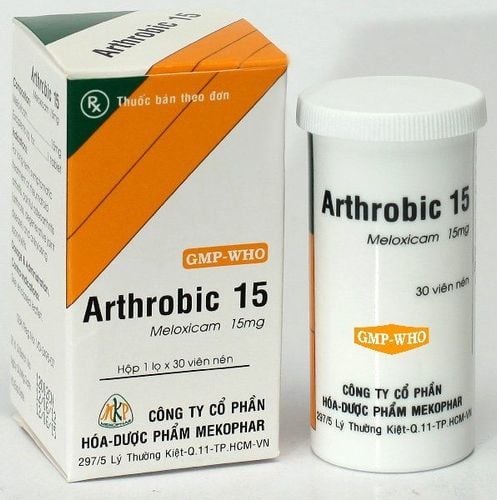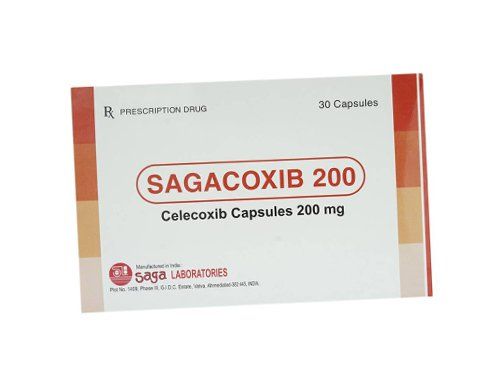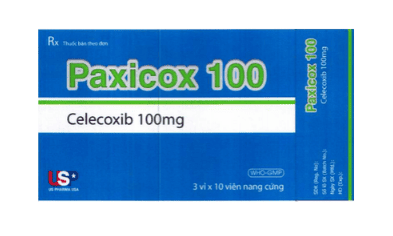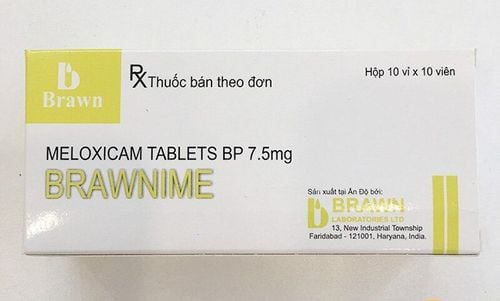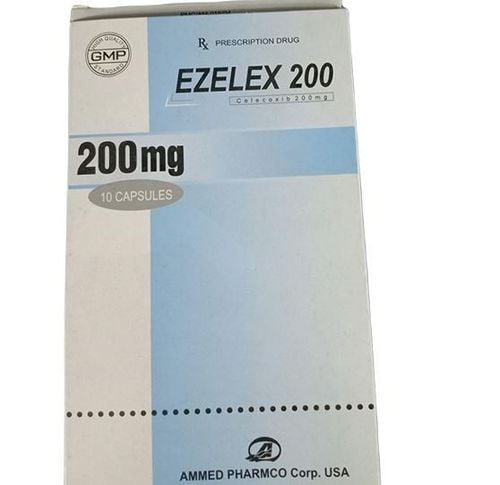This is an automatically translated article.
Nabucox 400 is a non-steroidal anti-inflammatory drug; commonly indicated in the treatment of rheumatoid arthritis and osteoarthritis in adults. The following article provides you with information about the uses and notes when using Nabucox 400.1. What is Nabucox 400?
What is Nabucox? Nabucox 400 has the main active ingredient is Celecoxib, the drug is made in the form of hard capsules with a content of 400mg. Celecoxib is a non-steroidal anti-inflammatory drug, selectively inhibits Cyclooxygenase-2 (COX-2) isoenzyme, has anti-inflammatory, antipyretic and analgesic effects. The mechanism of action of Celecoxib is inhibition of prostaglandin synthesis, mainly through inhibition of the isoenzyme cyclooxygenase-2 (COX-2).Unlike most previously available non-steroidal anti-inflammatory drugs, Celecoxib does not inhibit cyclooxygenase-1 (COX-1) isoenzyme at therapeutic concentrations in humans. COX-1 is an enzyme present in most tissues, monocytes and platelets. COX-1 is involved in blood clot formation (such as promoting platelet aggregation) maintenance of the gastric mucosal barrier and renal function. Because of its non-inhibiting effect on COX-1, the risk of Celecoxib causing side effects (eg, peptic ulcer, bleeding, prolongation of bleeding time) is less, but Celecoxib can cause renal side effects similar to the drug. other non-steroidal anti-inflammatory drugs. Celecoxib may increase the risk of vascular thrombosis in some patients because it inhibits prostaglandin synthesis (an antithrombotic agent) and has no effect on thromboxane A2 (a prothrombotic agent).
Besides, Celecoxib also works to prevent the proliferation of colon cancer cells, reducing the size of colorectal polyps.
2. Indications and contraindications of Nabucox 400
2.1. Point
Nabucox 400 is mainly indicated in the treatment of rheumatoid arthritis and osteoarthritis in adults.2.2. Contraindications
Allergy or hypersensitivity to Celecoxib, Sulfonamide or any of the ingredients in Nabucox 400. Progressive peptic ulcer. Gastrointestinal bleeding. Myocardial ischemia. Peripheral vascular disease and cerebrovascular disease. Congestive heart failure (NYHA class II-IV). Hepatic impairment (serum albumin concentration < 25 g/l or Child-Pugh ≥ 10 points). Severe renal impairment (creatinine clearance < 30 ml/min). Inflammatory bowel disease (such as ulcerative colitis, Crohn's disease). History of bronchial asthma, urticaria, or other allergic-type reaction after taking aspirin or other nonsteroidal anti-inflammatory drugs. Children, pregnant women and lactating women as safety has not been proven.3. How to take Nabucox 400
Nabucox 400 tablets are for oral use only as prescribed by a doctor. Nabucox 400 should be taken after meals, swallow the capsule whole with water. Dosage: Rheumatoid arthritis: 100-200mg/time x 2 times/day. Osteoarthritis: 200 mg/time/day or 100 mg/time x 2 times/day. Mild to moderate hepatic impairment: Reduce dose by half.4. Nabucox 400 overdose and treatment
Overdosage of nonsteroidal anti-inflammatory drugs causes drowsiness, lethargy, nausea, vomiting, and epigastric pain. These symptoms are usually reversible with supportive treatment. Gastrointestinal bleeding may occur. Rarer manifestations are hypertension, respiratory depression, acute renal failure, and coma. Anaphylactoid reactions have also been reported with therapeutic doses of nonsteroidal anti-inflammatory drugs and may occur with overdose.Management includes symptomatic treatment and support; Currently, there is no specific antidote to non-steroidal anti-inflammatory drugs. In the first 4 hours after an overdose of non-steroidal anti-inflammatory drugs, emetic therapy or oral activated charcoal can be applied (60-100g for adults, or 1-2g/kg in children). An osmotic bleach can be used for patients with pathological symptoms or for taking excessive amounts of the drug. It is not known if the dose of Celecoxib is removed by hemodialysis, but the high protein binding suggests that the use of forced diuresis, hemodialysis, alkalinization of the urine, or blood transfusion may be possible. does not effectively remove large amounts of Celecoxib from the body.
5. Some cautions when using Nabucox 400
Nonsteroidal anti-inflammatory drugs can cause serious gastrointestinal side effects with or without warning symptoms. It is necessary to closely monitor complications such as ulcers, bleeding, and perforation of the gastrointestinal tract when using Nabucox 400. Patients with hypertension, heart failure, cardiovascular disease or cardiovascular risk factors: Use the drug after careful consideration. Monitor during treatment to prevent possible cardiovascular events. History of asthma, allergy when taking Aspirin or NSAIDs: Anaphylaxis may occur. Some subjects need to be careful when using Nabucox 400: Impaired liver function, kidney failure, allergy or hypersensitivity to Celecoxib, the elderly... Pregnant women: There are currently no adequate studies. Regarding the use of Celecoxib in pregnant women, use the drug only when the potential benefit outweighs the possible risk to the fetus and mother. Especially do not use Celecoxib in the last 3 months of pregnancy because prostaglandin synthesis inhibitors can adversely affect the fetal cardiovascular system. Lactation: It is not known whether Celecoxib passes into breast milk. The benefits and risks of using Nabucox 400 in lactating women need to be assessed, considering whether to discontinue nursing or discontinue nursing.6. Undesirable effects
Undesirable effects when using Nabucox 400 are usually mild and mainly occur in the gastrointestinal tract. Undesirable symptoms that cause patients to stop taking the drug the most include indigestion and abdominal pain.Some possible undesirable effects: Headache, dizziness, gastritis, digestive disorders, enteritis, constipation, hepatitis, jaundice, allergic reactions, anemia, bronchitis . Less common: Angioedema or anaphylactic reaction.
Nabucox 400 is usually well-loaded when used in normal and short-term doses. In case of occurrence of adverse effects, should stop using Nabucox 400 and notify the doctor for timely treatment.
7. Interactions with other drugs
Angiotensin-converting enzyme inhibitors: Celecoxib may reduce the antihypertensive effect of ACE inhibitors. Furosemide and Thiazides: Non-steroidal anti-inflammatory drugs may reduce the diuretic effect of the drug. Fluconazole: Concomitant administration doubled the plasma concentration of celecoxib. Warfarin: When taking Celecoxib concurrently with Warfarin, bleeding complications and increased prothrombin time may occur in some patients (mainly elderly). Monitor blood clotting tests, prothrombin time, especially in the first few days after starting Nabucox 400 or changing therapy. Lithium: The renal clearance of Lithium may be reduced when co-administered with Celecoxib, resulting in increased plasma concentrations of lithium. Monitor patients closely for signs of lithium toxicity and adjust dose accordingly when starting or stopping Celecoxib.Please dial HOTLINE for more information or register for an appointment HERE. Download MyVinmec app to make appointments faster and to manage your bookings easily.




